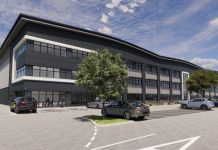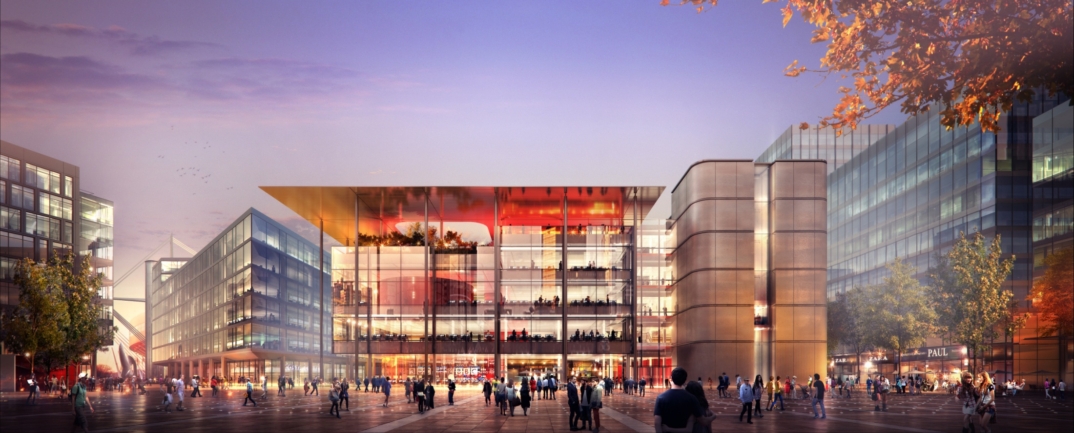Rhys James, Senior Director and Head of DTZ‘s office in South Wales this week addressed an invited audience of over 200 DTZ clients and professional colleagues at a breakfast presentation at Cardiff’s St David’s Hotel.
During the presentation, Rhys referred to several aspects of the property market in South Wales in 2014 which had represented a significant improvement on the challenging market conditions that had been experienced in 2013:
In the Industrial market he said that the sentiment was still a cautious one but that there were “clear signs of improvement.” St Modwen’s intend to start the first speculative industrial development in South Wales for 10 years when they commit to a new 50,000 sq ft unit at their Celtic Business Park at Llanwern and that is certainly an encouraging sign. On the retail front he referred to the large food store market imploding in 2014; a real disappointment for the South Wales region where so many brown field regeneration schemes in recent years have been anchored by multi-million pound commitments from one of the big four food store operators, however not any more. On the market for housing land he referred to the strong demand for well located and deliverable development sites from regional and national house builders, from Housing Associations and with gross land values, before deducting for S106 costs and abnormal development costs, varying from £350,000 per acre in West Wales and the northern valley’s towns to as much £1.5m per acre for the best sites in Cardiff and the Vale of Glamorgan. Rhys James’ most enthusiastic comments were reserved for the Cardiff office market which had seen take up in 2014 rise an exceptional 82% when compared with the 2013 figure; 542,000 sq ft was taken up in 2014 with 49% of that space being let in Cardiff city centre buildings.
Looking forward, he spoke at length about the plans that Rightacres and Cardiff City Council have for redeveloping Central Square, the area on the north side of Cardiff central Station, with over 1 million sq ft of new building due to be completed during the course of the next 5 or 10 years.
Central Square will have the new BBC HQ building of 160,000 sq ft as its focal point and work on that building is due to be commenced in summer 2015. He identified Rightacres’ decision to appoint Foster & Partners as the project architects as being a real inspiration. He added that they have been majorly impressive from day one in helping to deliver the BBC scheme. The remainder of Central Square will include 2 detached office buildings, the first of which is already on site at 135,000 sq ft, and due for completion at the end of 2015 with Blake Morgan solicitors as the first pre-let for 28,000 sq ft. Other new buildings which will be constructed during the course of the next 5 – 10 years will include those for hotel, private rented sector apartments, serviced apartments, retail and student residence use. The new complex to replace Marland House will include a world class transport interchange including the relocated bus station. Rhys James commented: “The BBC HQ building has undoubtedly been the catalyst which has enabled Central Square to come alive and to become a deliverable regeneration scheme. It will be part of a scheme which, when joined with Network Rail’s planned redevelopment of Cardiff Central Station, will project Cardiff in to the premier league of European capital cities.
DTZ presented its ‘2015 Outlook’ for the property market at the event, providing key insights for both occupiers and investors for the year ahead. The breakfast presentation revealed that UK commercial property investment reached an all-time high in 2014, with £54.9 billion transacted, with the increase driven by investment outside of London, which increased from £25.4bn in 2013 to £34.4bn in 2014.
The UK regions have been an attractive option, given the higher yields on offer than in London, and with occupier markets underpinned by increasing demand and ongoing limited supply. DTZ also observed a dramatic increase of the flows into domestic retail funds during the second half of 2013 and over 2014, boosting institutional demand.
Overseas investment continued to dominate in London, representing over 68% of transactions in 2014, but the real increase in overseas investment was again in the rest of the UK. This increased significantly from a 28% share of the total in 2013 to 36% in 2014, driven by significant surges in investment from the US, China and, in particular, Europe.
The breakfast presentation also revealed that commercial property investment in the UK as a whole reached an all-time high in 2014, with £56.2bn transacted, with the increase driven by investment in the UK regions outside of London, rising from £25.5bn in 2013 to £35.7bn in 2014.
Ben Clarke, Head of UK Research at DTZ commented: “The UK regions have been an attractive option, given the higher yields on offer than in London, and with occupier markets underpinned by increasing demand and ongoing limited supply.”
However, the most important issue impacting property remains the ongoing ultra-low interest rate environment that has almost certainly been prolonged into 2016 with the release of record low inflation figures. This is especially relevant since DTZ expects more UK property markets to be overvalued than undervalued by late 2015.
Ben Clarke explained: “The longer the yield spread between property and bonds is, and is expected to be favourable, the further property yields will be compressed. The UK all-property total return for 2015 is set to again be a double digit, though we expect it to fall short of 2014’s near-20% return. However, front-loading returns in this way comes at the cost of a sharper correction to commercial property down the line when the interest rate environment eventually normalises.”
The event also revealed that whilst the main drivers of returns have been on the investment side, there has also been a significant turnaround in most occupier markets. Office take-up in the key UK centres outside of central London was a record 5.7 million sq ft in 2014. A record volume of grade B lettings reflected the extreme shortage of grade A stock. However grade A pre-letting made a resurgence at the end of the year in response to a much-needed, albeit historically small, increase in the development pipeline.
The Industrial market had a record volume of grade A take-up in the first half of 2014, and overall 2014 lettings were the highest since 2008. DTZ has tracked an increase in demand for large distribution hubs as retailers adapt their strategies in response to ongoing increases in online spending and the ‘click and collect’ phenomenon which took hold in 2014. This has helped kick-start industrial speculative development in the Midlands and the South East.
Andrew Gibson, DTZ Associate Director, Investment Agency added: “The £655m invested in Wales throughout 2014 outperforms even the pre-recessionary years of 2005 to 2008. The weight of money that started to enter the market in 2013/14 has continued to drive yield compression into the regions and prime yields seem set on a downward trend throughout 2015. The UK’s vastly improved economic platform has bolstered investor confidence and created a credible occupational story that reduces investor risk when looking at even some of the more secondary assets. As 2015 progresses, the secondary market looks set to gather momentum which will produce a reducing gap between prime and secondary yields, ultimately benefiting the investment market in Wales.
“Portfolio premiums played a large part in the 2014 market and it appears that this will continue into 2015 with US Investment Fund, Karlin Real Estate launching the sale of their first portfolio last week, which includes the BAAE Facility in Llantrisant, which is an asset they only acquired in 2014.
“There were some notable high volume transactions in 2014 with the sale of Parc Trostre, Llanelli for £156m and Capital Shopping Park, Cardiff for £56.65m. With the weight of money continuing to build and the regional markets remaining attractive to investors, it is likely that, post the historically low pre-election slow down, further high volume transactions will be seen in H2 2015.”





















